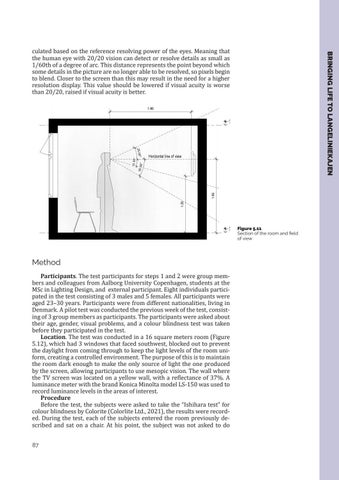BRINGING LIFE TO LANGELINIEKAJEN
culated based on the reference resolving power of the eyes. Meaning that the human eye with 20/20 vision can detect or resolve details as small as 1/60th of a degree of arc. This distance represents the point beyond which some details in the picture are no longer able to be resolved, so pixels begin to blend. Closer to the screen than this may result in the need for a higher resolution display. This value should be lowered if visual acuity is worse than 20/20, raised if visual acuity is better.
Figure 5.11 Section of the room and field of view
Method Participants. The test participants for steps 1 and 2 were group members and colleagues from Aalborg University Copenhagen, students at the MSc in Lighting Design, and external participant. Eight individuals participated in the test consisting of 3 males and 5 females. All participants were aged 23–30 years. Participants were from different nationalities, living in Denmark. A pilot test was conducted the previous week of the test, consisting of 3 group members as participants. The participants were asked about their age, gender, visual problems, and a colour blindness test was taken before they participated in the test. Location. The test was conducted in a 16 square meters room (Figure 5.12), which had 3 windows that faced southwest, blocked out to prevent the daylight from coming through to keep the light levels of the room uniform, creating a controlled environment. The purpose of this is to maintain the room dark enough to make the only source of light the one produced by the screen, allowing participants to use mesopic vision. The wall where the TV screen was located on a yellow wall, with a reflectance of 37%. A luminance meter with the brand Konica Minolta model LS-150 was used to record luminance levels in the areas of interest. Procedure Before the test, the subjects were asked to take the “Ishihara test” for colour blindness by Colorite (Colorlite Ltd., 2021), the results were recorded. During the test, each of the subjects entered the room previously described and sat on a chair. At his point, the subject was not asked to do 87
